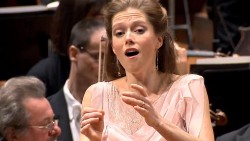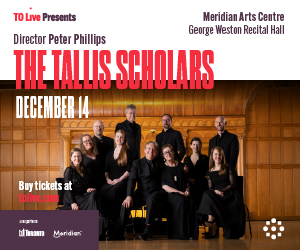 The Toronto Symphony’s New Creations Festival is turning out to be a remarkable blend between premieres of works not heard in Canada before, including two newly commissioned pieces and an experience of breaktaking performances by Canadian soprano Barbara Hannigan who was featured in the February issue of The WholeNote. With one show of the festival remaining on Saturday March 7 and the entire night devoted to a concert version of guest composer George Benjamin’s opera Written on Skin, all I can say is if you’re reading this before Saturday, you need not even think twice. It’s going to be spellbinding.
The Toronto Symphony’s New Creations Festival is turning out to be a remarkable blend between premieres of works not heard in Canada before, including two newly commissioned pieces and an experience of breaktaking performances by Canadian soprano Barbara Hannigan who was featured in the February issue of The WholeNote. With one show of the festival remaining on Saturday March 7 and the entire night devoted to a concert version of guest composer George Benjamin’s opera Written on Skin, all I can say is if you’re reading this before Saturday, you need not even think twice. It’s going to be spellbinding.
But before jumping ahead into the future, a look back at what has already transpired is in order. The two works that stood out for me at the February 28 concert were both devoted to studies of “a mind of winter,” which just happens to be the title of the work composed by Benjamin and performed by Hannigan that evening. As soon as the conductor’s baton was raised, from my close vantage point I could see Hannigan immediately begin to breathe into and with the sounds coming from the orchestra. I remembered what she had said in the interview we had for the February cover story – that when she sings she becomes fully a part of a large body making sound and breathing. She went on to say “that’s what makes singers so unique – because the voice is the most vulnerable of instruments, when you are connected with your whole body, your whole being is on display.” She so fully took the audience into this mind of winter state, that listening to the music lifted the listener far beyond the drudgery of winter into a place of stillness and exquisite beauty.
The second work of the evening that paralleled this journey into winter’s translucence was Canadian composer Vivian Fung’s commissioned Violin Concerto Of Snow and Ice, written for TSO’s concertmaster Jonathan Crow. The piece was full of storm and drama, as winter can also be, with furious passages for the violin and resounding dense textures from the orchestra. By the end though, something had settled and winter had created a spell that for me was hard to leave once the applause broke out.
The evening of March 4 began with a pre-concert in the lobby featuring performances by one of Toronto’s fast growing opera companies – the unique Bicycle Opera Project. They bicycle from one concert to another with props, costumes and instruments in tow. Co-founder Larissa Koniuk told me after the show that this summer they will be expanding their reach to performing and cycling in Cape Breton before returning to Ontario. In the RTH north lobby setting the short scenes they presented were full of drama, wit and skillful performances.
Once the concert began, the hall was filled with the striking orchestral colours and textures heard in the opening two works: the world premiere of Chris Paul Harman’s Lieder und Arien and the Canadian premiere of George Benjamin’s Duet for Piano and Orchestra. During the intermission talk, Harman spoke about how as a younger composer he studied the works of Benjamin to gain insight into how to build an orchestral palette. His piece passed baroque-era chorale melodies amongst the wind and brass instruments backed up by shimmering percussion, harps and a collection of keyboard instruments. Benjamin’s duet was a timbre-filled dialogue between the piano’s extensive range of pitches and harmonic capabilities and a scaled-down version of orchestral resources. Who belongs where was the underlying question being bandied about.
The evening though was stolen away by the North American premiere of let me tell you, composed by Hans Abrahamsen using text from Paul Griffiths’ novel of the same name. Although Griffiths’ text was created using only the words Shakespeare gave Ophelia in Hamlet, the Ophelia we meet in Abrahamsen’s version has been completely transformed into a woman looking back at her journey through time while musing on the nature of memory and the being we call music.
Once again, it was Hannigan’s performance in her embodiment of Ophelia’s spirit that elevated music into the transpersonal realm. And as she came to her conclusions about the power of music in the third part of the piece, the entire orchestra was shifting and gliding through microtonal layerings reminiscent of a slow carousel ride. In an interesting twist of programming fate, the piece ends up within a snow-bound landscape, symbolic in this work of a new state of resonance that imbues itself within Ophelia. I highly recommend reading the extensive program notes on the New Creations website about this piece, which also includes the text.
The rousing standing ovation this performance received is indicative of how transporting this work is, indeed how transformative. It is rare for a contemporary work to garner such a level of response, and it is due in part to the exceptional capacity that Hannigan inhabits of complete surrender to body, breath, voice and psyche.
The final concert March 7 promises to be the culminating peak of the festival when Hannigan along with four other singers perform Benjamin’s emotionally charged Written on Skin.


